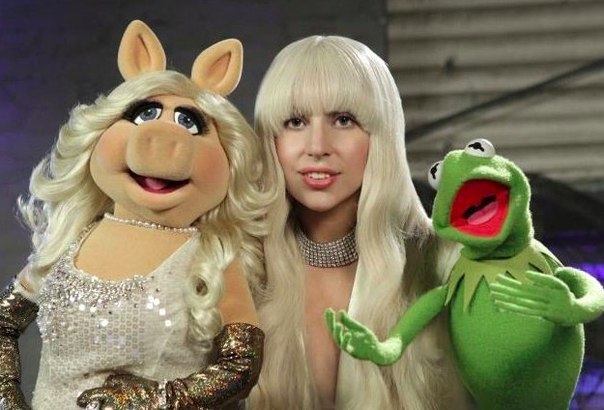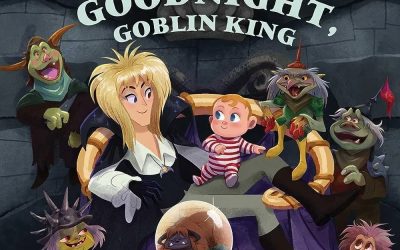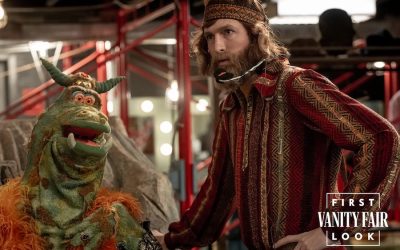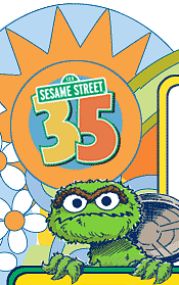
So here’s the joke: Two Muppet fans are walking down the street. One of them says, “I hate that DVD. It’s not funny, the acting is terrible, and the story doesn’t make sense.”
“I know,” says the other fan. “And it’s not even in widescreen!”
Fans are pretty easy to understand, as long as you understand that we only want one thing, which is: More than we have. The CD is never long enough, there are never enough episodes of the show. If the box set of uncut rarities has eleven episodes, then we want it to have twelve.
When fans complain — and you can tell when a fan is complaining, because his lips are moving — it’s usually because we want more. Why can’t this thing be more like the thing that I want, which is essentially a never-ending drip feed of everything I love best? Fans complain because we feel deprived — but our capacity is infinite, so we feel deprived pretty much all the time.
Now, this year, Sesame Street is turning 35, and they’re celebrating with a bunch of anniversary specials — a DVD special (What’s The Name of That Song?), a CD box set (Songs From the Street), and a special season-opener episode called The Street That We Live On.
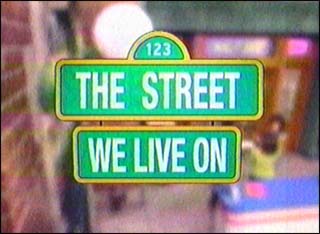
With these three anniversary tributes, Sesame Street is essentially trying to act like a fan, commemorating its own history in the way that fans do. But is it possible for a show to be a fan of itself? If fans always want more, more, more — then can you be a fan, if you’re the one who actually has to go and deliver it?
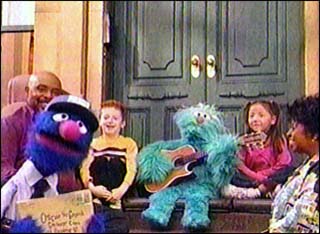
The Street That We Live On begins with the perfect fanboy opening sequence: Grover making a delivery from the Mail-It Shop to Oscar’s trash can, going the length of Sesame Street and running across pretty much every current major character on the show. He bumps into Bob, yells hello to Ernie and Bert, compliments Rosita as she plays guitar for Susan and Gordon. The Count counts chickens, Cookie Monster eats cookies — everybody’s in their proper place, and all is right with the world.
Deep down, this is what fans want the show to be all the time — everybody we love is there, all together.
It also happens to be a perfect expression of what Sesame Street is doing well these days. Just having Grover front and center feels wonderful. This is Eric Jacobson’s third season performing Grover, and it still feels like a brand-new present to me.
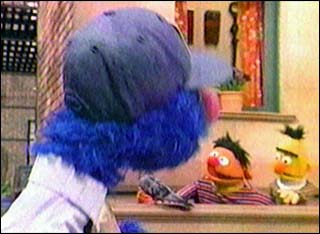
Grover spent so many years in limbo, only appearing in insert skits when Frank Oz’s directing schedule would allow him to shoot some Grover bits. Now Grover’s back in front, even more than before, with a prominent role both in this special and in the What’s The Name Of That Song DVD. It’s like our best friend moved away years ago and we gradually lost touch — but now he’s moved next door again, and we see him all the time.
The production values are also impossibly great. Just having this long tracking shot involving complicated, clever interactions with all the characters is wonderful and ambitious. The puppets look amazing, bright and cheerful, and we see them in varied poses. The lighting, the video quality, the editing — this is a beautiful piece of work.
Then Big Bird and Snuffy come around the corner, and we see them from Grover’s point of view as they trample past him. It’s a fantastic shot, the kind of thing that was entirely beyond their scope 35 years ago — or even 20 years ago, maybe even 10. Sesame Street looks better now, more polished and attractive, than it ever looked before.
It’s like I keep trying to tell people: You look your best when you hit your mid-30’s. Sesame Street, as always, is proving my point.
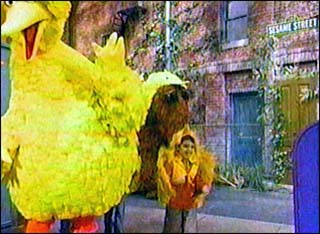
Grover brings the package to Oscar, and it turns out to be a picture from Elmo: he spilled spaghetti on it, so he thought Oscar would like it. Oscar loves it, of course, and snaps: “Where is the little red menace?” This is the cue to transition over to Elmo’s World, where Elmo is thinking about Sesame Street. (“You know — Sesame Street!”)
So this, sadly, is where at least some of the longtime Sesame fans check out. During the lean years in the mid-90’s, before they recast Henson’s and Oz’s characters, there was a huge vacuum on the Street: they didn’t have Ernie, Bert, Grover or Cookie Monster to play with, so Elmo ended up filling the gap left by the loss of all four characters.
As it turns out, Elmo was essentially keeping the place warm for them, helping it to tick over until they decided to take the plunge and recast all those characters — but at the time, it looked like Elmo was taking over, pushing out the characters that we loved and hogging the spotlight. Some fans still hold a grudge against Elmo, even now that we have our other monsters back. That’s show biz for you.
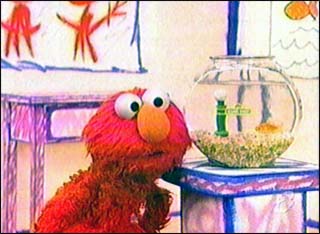
Anyway, sticking Elmo right in the middle of our anniversary special is like waving a red monster in front of a bull for these fans. They don’t like Elmo’s World, and they don’t want it taking up all this space. They resent having Elmo there at all.
Of course, the thing that those cranky fans miss is how Elmo is celebrating the enduring power of Sesame Street. Dorothy’s opening question is: How does Cookie Monster eat a cookie? Elmo asks Mr Noodle to show her, and some kids have a turn, and then Elmo asks a baby. Turns out this is a really effective way to demonstrate how Sesame Street got into our heads, just moved in there and started taking up space that can never be reclaimed.
Naturally, the kids can do an impression how Cookie Monster eats a cookie. Every kid in the world knows how Cookie Monster eats a cookie. It’s actually a neat little experiment that would be fun to try the next time you’re hanging out with a kid: Give them a cookie, and ask them how Cookie Monster would eat it. I’ll bet they do it for you.
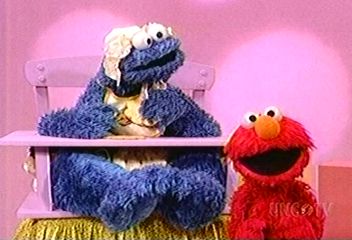
Plus, the really fun thing is you’d get the same result if you asked any adult under the age of 35 the same question. We can all do it, every one of us: generation after generation of people who could, with no warning or rehearsal time, spew crumbs all over the room and make yummy crunching noises on cue. That’s amazing, when you think about it.
Anyway, that leads into a clip of opera singer Marilyn Horne singing “C is for Cookie” in a grand production number. Then there’s that cool cartoon typewriter who goes noo-nee-noo-nee-noo, and a short film with live-action kids dancing with a C. Then there’s an excellent new computer-animated bit about Traction Jackson, a young boy singing a cheerful song about how much he likes his wheelchair, because it helps him get around. Finally, we’ve got a cute bit with Gabi building a little casa for Slimey.
As a little collection of random bits — namely, any given five-minute stretch of Sesame Street — then that’s just as good of a representative sample as any. Traction Jackson looks brand new to me; the noo-nee-noo typewriter was around when I was a kid. There’s a funny guest star, and a happy moment for the Muppet worm. In the space of five inserts, they’ve taught us about a letter of the alphabet, opera singing, and a Spanish word, and given us a pro-social message about kids in wheelchairs. And that’s just in a few minutes! They show a whole hour of this every single day. Kids who watch this show must be geniuses by the end of a year.
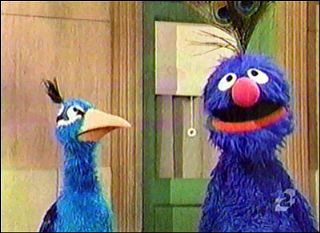
And as we go on through the hour, there’s just more and more. Elmo introduces Journey to Ernie, and we see Big Bird hunting for Ernie in a cartoon fairytale kingdom. Ernie and Bert sing “Dance Myself to Sleep,” which now includes a celebrity dance-along bit in the middle with Harvey Fierstein and Seth Green. (I used to dread these celebrity singalong versions — but either they’ve gotten better at them, or I’ve gotten more patient, because I think this one is fun.)
In today’s Global Grover bit, Grover presents us with Ming, a Muppet peacock who’s supposed to show us how to do the Chinese peacock dance. Ming does a soft-shoe tap dance instead, so Grover has to show us a film clip of Chinese kids doing the peacock dance. Grover and Ming end the piece by tap dancing together.
It’s honestly just incredible. One spot after another, they just nail it. Even 35 years in, even with budget cuts and a reduced number of episodes, Sesame Street is producing high-quality stuff. For comparison, just check out what’s playing on Noggin these days at any given hour. It’s dire, completely unwatchable. Even infants crawl for the exit when you turn it on.
Meanwhile, on Sesame Street, I can totally imagine being a two-year-old today, and just falling head over heels in love with Grover and Cookie Monster and Big Bird. Check in with today’s two-year-olds in a couple decades; they’ll remember when Grover went to all the different countries. I’ll bet you anything they do.
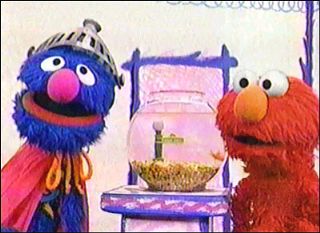
Meanwhile, back in Elmo’s World, Elmo wants to know more about Sesame Street. And who doesn’t? So Super Grover shows up, to bring Elmo back in time to the Sesame Street that existed before he was born. He drives Elmo in a taxi back through space and time, to show him some old clips from the show’s past.
Now here’s a sad thing about fans: This is supposed to be one of the special moments included specifically for the adults who love the show — for the parents, really, but we’ll stick fans in here too — and yet this is the part that made the hardcore Sesame fans just fume and fuss. They got all kinds of cranky about this part. Why? Because they didn’t show enough old clips, and because the whole bit really focuses more on Grover and Elmo’s interaction in the taxi cab than the clips themselves.
For example: Grover brings Elmo back to an old clip, and explains: “This is the happy day Susan and Gordon adopted Miles into their family. And they are a family still. And Gordon is bald still. Some things never change.”
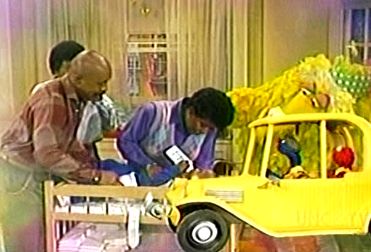
And then they go on to the next clip. Now, you or I might say, that’s an extremely funny Grover joke, and we would love it, and be happy. But the hardcore Sesame fans — they’re good people, they really are — but they were unhappy about that kind of moment. I was involved in one discussion right after the episode aired, and the word “abomination” was used. Seriously! And what they were talking about was that very sequence.
I think this is the problem: Teenagers and adults who are Sesame Street fans today — at least the ones who aren’t parents with little kids — they’re fans of what the show used to be, back when they were three and watching it for the first time. So when they see an anniversary tribute, the thing that they want more, more, more of is the old stuff — more Ernie and Bert sketches from the 70’s, more old songs, more forgotten characters like Don Music or Sam the Robot.
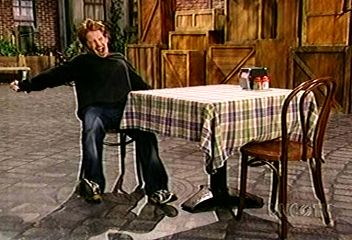
The show is being a fan of itself in this episode, but it’s a fan of what the show is, rather than what it was. The show wants more, more, more of what’s new, and especially the best of what’s new — more of Eric Jacobson’s Grover, more Elmo’s World, more of Seth Green and Gabi and Dorothy and Rosita playing the guitar. They’re tripping over themselves to show off all the stuff they do well right now. This is essentially Now That’s What I Call Sesame Street!, volume 35.
When Sesame Street hit their 20th anniversary, they did a network special called “Sesame Street: 20 Years and Counting,” with Bill Cosby hosting a big survey-course look back at all the cool stuff they’d done over two decades. There were way more old clips and tributes to individual characters in that show. But that was 15 years ago, and by now, they’ve accumulated even more memories and characters and big moments. It was possible to take a stab at being representative of the 20-year history back then; I’m not sure that’s possible anymore. There’s just been too much stuff by now to ever really hope to put together a comprehensive sampling. It wouldn’t fit.
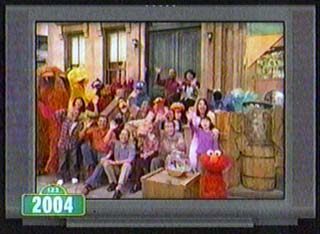
So they didn’t try this time. Instead, they made a big messy episode of the show, throwing in all the stuff that they currently do, and adding a big dose of self-love. And if they don’t deserve to love themselves this much after 35 years of consistently top-drawer educational television, then I don’t know who does.
At the end, Elmo runs outside and yells for everybody on the street to get together. Remarkably, everyone drops what they’re doing to come sit on the brownstone steps and listen to him. If one were cynical, which naturally one is, then one might note that Elmo can snap his fingers and order the whole rest of the cast around at his whim. But never mind that.
Elmo’s big announcement is: “Elmo loves Sesame Street and his friends very, very much!” Which is nice, but not necessarily worth crossing the street for if you ask me. But then they sing “The Street We Live On,” a nice big production number with all the people and all the Muppets together, singing about how much they love their own TV show. Everybody gets a line, and a smile, and a character moment.
You might love the Sesame Street of 1974 better than this, because you happened to be three back then, and you aren’t three anymore. But, damn, if they could be making better Sesame Street than they’re making right now… well, I just don’t know how they would manage it. It doesn’t seem possible.
So, as a lifelong fan, all I can say is: Thank you, and happy 35th anniversary. And, as always: More, more, more.
by Danny Horn

